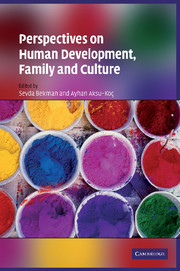Book contents
- Frontmatter
- Contents
- List of figures
- List of tables
- List of contributors
- Preface
- Foreword
- Selected international publications by Çiğdem Kağıtçıbaşı
- I Cultural and cross-cultural psychology: selected perspectives
- II Development in the family context
- 5 Organizing principles and processes from developmental science for culture and caregiving
- 6 A social change and human development perspective on the value of children
- 7 Turkish family structure and functioning
- 8 Mothers' and fathers' child-rearing practices and self-esteem in three generations of urban Turkish families
- III Culture and self
- IV Social change, family, and gender
- V Induced change
- Epilogue
- Subject Index
- Author Index
- References
5 - Organizing principles and processes from developmental science for culture and caregiving
Published online by Cambridge University Press: 04 August 2010
- Frontmatter
- Contents
- List of figures
- List of tables
- List of contributors
- Preface
- Foreword
- Selected international publications by Çiğdem Kağıtçıbaşı
- I Cultural and cross-cultural psychology: selected perspectives
- II Development in the family context
- 5 Organizing principles and processes from developmental science for culture and caregiving
- 6 A social change and human development perspective on the value of children
- 7 Turkish family structure and functioning
- 8 Mothers' and fathers' child-rearing practices and self-esteem in three generations of urban Turkish families
- III Culture and self
- IV Social change, family, and gender
- V Induced change
- Epilogue
- Subject Index
- Author Index
- References
Summary
Human development is socialization, together with maturation. It encompasses the lifelong process of becoming social, becoming a member of a society. Thus, it involves constant interaction with the socio-cultural environment. Any study of human development, therefore, must have contextual and temporal dimensions. Indeed, significant trends in these directions are getting established with the rise of cultural and cross-cultural psychology on the one hand, and lifespan developmental approaches on the other.
(Kağıtçıbaşı (1996: 19)Introduction
Çiğdem Kağıtçıbaşı's (1996) Model of Family Change (MFC) provides a systematic framework to analyze dynamic intergenerational relationships with equally dynamic socio-economic conditions. The model assigns a key role to the family as mediator between culture and self. This role, through which core cultural values are handed down across generations, is not passive. Rather, the family is cast as an active agent that selectively transmits cultural values and continually adapts to changing circumstances. This chapter discusses culture, caregiving, and child development in a way intended to complement and supplement Kağıtçıbaşı's seminal contributions.
Human beings do not grow up, and adults do not parent, in isolation, but in multiple contexts, and one notable context is culture. Culture infuses developmental and psychological phenomena and is inseparable from them. Culture is therefore a crucial desideratum in caregiving and child development. All societies prescribe certain characteristics that their members are expected to possess, and proscribe others they must not do, if they are to behave acceptably as members of the society (Harkness and Super 2002).
- Type
- Chapter
- Information
- Perspectives on Human Development, Family, and Culture , pp. 69 - 85Publisher: Cambridge University PressPrint publication year: 2009
References
- 2
- Cited by



